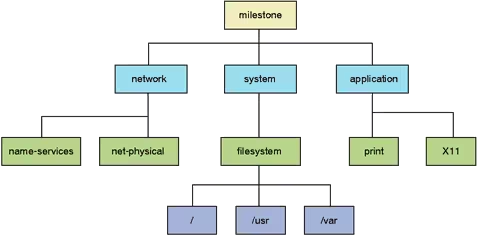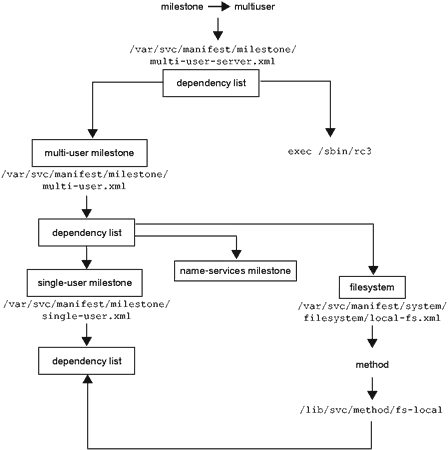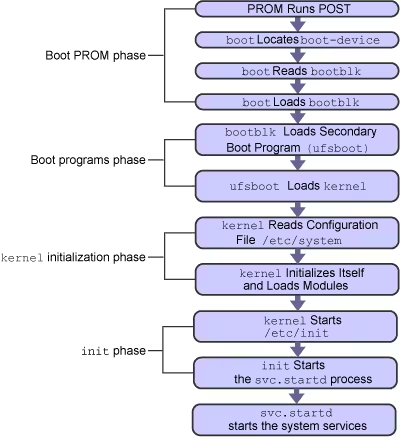SMF: Service Management Facility
Introduction
SMF services are listed by categories:
- application
- device
- legacy
- milestone
- network
- platform
- site
- system
Example:
svc:/system/filesystem/root:default
- The prefix svc indicates that it’s a service managed by SMF
- The category of the service is “system”
- The service itself is a filesystem
- The instance of the service is the root of the file system
- The word “default” identifies the first, in this case only, instance of the service
Another example:
lrc:/etc/rc3_d/S90samba
- The name “lrc” indicates that the running service is not managed by SMF
- The pathname “/etc/rc3_d” refers to the folder “/etc/rc3.d” where the script is used to be managed
- The script name is S90samba
To list the names and states of services:
$ svcs
STATE STIME FMRI
legacy_run Feb_10 lrc:/etc/rc2_d/S10lu
legacy_run Feb_10 lrc:/etc/rc2_d/S20sysetup
legacy_run Feb_10 lrc:/etc/rc2_d/S90wbem
legacy_run Feb_10 lrc:/etc/rc2_d/S99dtlogin
legacy_run Feb_10 lrc:/etc/rc3_d/S81volmgt
(output removed)
online Feb_10 svc:/system/system-log:default
online Feb_10 svc:/system/fmd:default
online Feb_10 svc:/system/console-login:default
online Feb_10 svc:/network/smtp:sendmail
online Feb_10 svc:/milestone/multi-user:default
online Feb_10 svc:/milestone/multi-user-server:default
online Feb_10 svc:/system/zones:default
offline Feb_10 svc:/application/print/ipp-listener:default
offline Feb_10 svc:/application/print/rfc1179:default
maintenance 10:24:15 svc:/network/rpc/spray:default
Here’s the list of possible states:
| State | Description |
|---|---|
| online | The service instance is enabled and has successfully started. |
| offline | The service instance is enabled, but the service is not yet running or available to run. |
| disabled | The service instance is not enabled and is not running. |
| legacy_run | The legacy service is not managed by SMF, but the service can be observed. This state is only used by legacy services. |
| uninitialized | This state is the initial state for all services before their configuration has been read. |
| maintenance | The service instance has encountered an error that must be resolved by the administrator. |
| degraded | The service instance is enabled, but is running at a limited capacity. |
Runlevels and Milestones Management
Here are the different service types:
- single-user
- multi-user
- multi-user-server
- network
- name-services
- sysconfig
- devices
Here’s the relationship between milestones and services:

Here’s an example of the relationship between dependencies:

To determine the current milestones:
$ svcs
Here are the states that a milestone can take:
- none
- single-user
- multi-user
- multi-user-server
- all
To choose which milestone you want to boot into:
ok> boot -m milestone=single-user
Note: svc.startd is a daemon.
The database listing all these services is located here:
/etc/svc/repository.db
This database is managed by the svc.configd service.
If there’s an error at this level, your machine won’t boot. To repair this, boot in single user mode and run this command:
/lib/svc/bin/restore_repository
Here’s a list of milestones and runlevels:
| Run Level | Milestone | Description |
|---|---|---|
| 0 | System is running the PROM monitor. | |
| s or S | single-user | Solaris OS single-user mode with critical file systems mounted and accessible. |
| 1 | The system is running in a single-user administrative state with access to all available file systems. | |
| 2 | multi-user | The system is supporting multiuser operations. Multiple users can access the system. All system daemons are running except for the Network File System (NFS) server and some other network resource server related daemons. |
| 3 | multi-user-server | The system is supporting multiuser operations and has NFS resource sharing and other network resource servers available. |
| 4 | This level is currently not implemented. | |
| 5 | A transitional run level in which the Solaris OS is shut down and the system is powered off. | |
| 6 | A transitional run level in which the Solaris OS is shut down and the system reboots to the default run level. |
To know which runlevel you’re in, use this command:
who -r
For runlevels, you can find in /etc/ or /sbin the different runlevels:
- rc0
- rc1
- rc2
- rc3
- rc4
- rc5
- rc6
- rcS
When you look in one of these folders, you can see boot and stop processes. To distinguish them:
- K for Kill
- S for Start
To know the current process with respect to the daemon:
$ ls -i S90samba
4715 samba
The Boot Process
If you’ve followed along correctly, you should understand that the boot order looks like this:
- PROM boot phase
- Boot program phase
- Kernel initialization phase
- Init phase
- svc.startd phase

During the boot phase, the kernel reads its configuration file /etc/system, then loads modules. It uses the “ufsboot” command to load the files.
Then it loads the /etc/init daemon.
Here’s what you can find in the /etc/system file:
- moddir
Searches for any modules to load
- root device and root file system configuration
By default: rootfs:ufs
This is for the root file system. Example:
rootdev:/sbus@1,f8000000/esp@0,800000/sd@3,0:a
- exclude
Won’t load the listed modules. Example:
exclude: sys/shmsys
- forceload
Forces loading certain modules. Example:
forceload: drv/vx
- set
Changes kernel parameters to modify system operations. Example:
set maxusers=40
Make a copy of the /etc/system file before saving changes. If the file is incorrect, you won’t be able to boot. If you have a problem with the modified file, here’s the solution to repair:
$ ok boot -a
Enter filename [kernel/sparcv9/unix]:
Enter default directory for modules [/platform...]:
Name of system file [etc/system]: etc/system.orig - or - /dev/null
root filesystem type [ufs]:
Enter physical name of root device [/...]:
(further boot messages omitted)
Inittab
Each line in this file looks like this:
id:rstate:action:process
Here are the fields:
| Field | Description |
|---|---|
| id | Two character identifier for the entry |
| rstate | Run levels to which this entry applies |
| action | Defines how the process listed should be run For a description of the action keywords see man inittab |
| process | Defines the command to execute |
By default, here’s what you find in the inittab file:
ap::sysinit:/sbin/autopush -f /etc/iu.ap
sp::sysinit:/sbin/soconfig -f /etc/sock2path
smf::sysinit:/lib/svc/bin/svc.startd >/dev/msglog 2<>/dev/msglog </dev/console
p3:s1234:powerfail:/usr/sbin/shutdown -y -i5 -g0 >/dev/msglog 2<>/dev/msglog
For possible actions, we have:
- sysinit
Executes the process before the init process tries to access the console (for example, the console login prompt). The init process waits for completion of the process before it continues to read the inittab file.
- powerfail
Executes the process only if the init process receives a power fail signal.
The svc.startd daemon is the replacement for init. To view the current configuration:
/var/svc/manifest
If you want to see milestone files to edit them:
single-user.xml
multi-user.xml
multi-user-server.xml
network.xml
name-services.xml
sysconfig.xml
/sbin/rc2
/lib/svc/method/fs-local
SVCS
Here’s the command to monitor SMF services:
$ svcs
STATE STIME FMRI
legacy_run 13:45:11 lrc:/etc/rcS_d/S29wrsmcfg
legacy_run 13:45:37 lrc:/etc/rc2_d/S10lu
legacy_run 13:45:38 lrc:/etc/rc2_d/S20sysetup
legacy_run 13:45:38 lrc:/etc/rc2_d/S40llc2
legacy_run 13:45:38 lrc:/etc/rc2_d/S42ncakmod
legacy_run 13:45:39 lrc:/etc/rc2_d/S47pppd
(output omitted)
online 13:45:36 svc:/network/smtp:sendmail
online 13:45:38 svc:/network/ssh:default
online 13:45:38 svc:/system/fmd:default
online 13:45:38 svc:/application/print/server:default
online 13:45:39 svc:/application/print/rfc1179:default
online 13:45:41 svc:/application/print/ipp-listener:default
online 13:45:45 svc:/milestone/multi-user:default
online 13:45:53 svc:/milestone/multi-user-server:default
online 13:45:54 svc:/system/zones:default
online 8:46:25 svc:/system/filesystem/local:default
online 8:46:26 svc:/network/inetd:default
online 8:46:32 svc:/network/rpc/meta:tcp
online 8:46:32 svc:/system/mdmonitor:default
online 8:46:38 svc:/milestone/multi-user:default
online 13:14:35 svc:/network/telnet:default
maintenance 8:46:21 svc:/network/rpc/keyserv:default
To verify the status of a service:
$ svcs svc:/system/console-login:default
STATE STIME FMRI
online 14:38:27 svc:/system/console-login:default
To view the dependencies of a service:
svcs -d svc:/system/filesystem/local:default
STATE STIME FMRI
online 14:38:15 svc:/system/filesystem/minimal:default
online 14:38:26 svc:/milestone/single-user:default
This shows what a service needs (dependencies):
$ svcs -d milestone/multi-user:default
STATE STIME FMRI
online 13:44:53 svc:/milestone/name-services:default
online 13:45:12 svc:/milestone/single-user:default
online 13:45:13 svc:/system/filesystem/local:default
online 13:45:15 svc:/network/rpc/bind:default
online 13:45:16 svc:/milestone/sysconfig:default
online 13:45:17 svc:/system/utmp:default
online 13:45:19 svc:/network/inetd:default
online 13:45:31 svc:/network/nfs/client:default
online 13:45:34 svc:/system/system-log:default
online 13:45:36 svc:/network/smtp:sendmail
Here we can see other services that depend on /system/filesystem/local:
$ svcs -D svc:/system/filesystem/local
STATE STIME FMRI
disabled 14:38:00 svc:/network/inetd-upgrade:default
disabled 14:38:07 svc:/network/nfs/server:default
online 14:38:30 svc:/network/inetd:default
online 14:38:30 svc:/network/smtp:sendmail
online 14:38:30 svc:/system/cron:default
online 14:38:30 svc:/system/sac:default
online 14:38:45 svc:/system/filesystem/autofs:default
online 14:38:47 svc:/system/dumpadm:default
online 14:38:51 svc:/milestone/multi-user:default
svcadm
This command is used to change the state of a service:
$ ps -ef
$ svcs cron
STATE STIME FMRI
online 14:38:30 svc:/system/cron:default
$ svcadm -v disable system/cron:default
system/cron:default disabled.
svcs cron
STATE STIME FMRI
disabled 20:35:25 svc:/system/cron:default
ps -ef
$ svcadm -v enable system/cron:default
system/cron:default enabled.
$ svcs cron
STATE STIME FMRI
online 20:35:59 svc:/system/cron:default
$ ps -ef
To temporarily disable the cron service:
svcadm -v disable -t system/cron:default
svc:/system/cron:default temporarily disabled.
Managing a Non-SMF Service
init.d is here:
$ svcs
$ ps -ef
ls /etc/init.d/volmgt
/etc/init.d/volmgt
/etc/init.d/volmgt stop
$ ps -ef
$ /etc/init.d/volmgt start
volume management starting.
$ ps -ef
svcs
Creating a Service Managed by SMF
This procedure can be a bit complex for the uninitiated. Here’s the chronological order to follow:
- Determine which milestones and run levels this service should be available at, and the appropriate command to start and stop the service.
- Establish relationships between dependencies, the service, and other services.
- Create a script in
/lib/svc/methodto start the process if necessary. - Create an .xml file in the appropriate subdirectory.
- Make a copy of the “Service Repository Database”.
- Integrate this script into SMF using the svccfg utility.
Create the file /lib/svc/method/newservice:
#!/sbin/sh
#
# Copyright 2004 Sun Microsystems, Inc. All rights reserved.
# Use is subject to license terms.
#
# ident "@(#)newservice 1.14 04/08/30 SMI"
case "$1" in
'start')
/usr/bin/newservice &
;;
'stop')
/usr/bin/pkill -x -u 0 newservice
;;
*)
echo "Usage: PAGECONTENT { start | stop }"
;;
esac
exit 0
Set permissions:
chmod 744 /lib/svc/method/newservice
Then create the file /var/svc/manifest/site/newservice.xml:
<?xml version="1.0"?>
<!DOCTYPE service_bundle SYSTEM "/usr/share/lib/xml/dtd/service_bundle.dtd.1">
<!--
Copyright 2004 Sun Microsystems, Inc. All rights reserved.
Use is subject to license terms.
ident "@(#)newservice.xml 1.2 04/09/13 SMI"
-->
<service_bundle type='manifest' name='OPTnew:newservice'>
<service
name='site/newservice'
type='service'
version='1'>
<single_instance/>
<exec_method
type='method'
name='start'
exec='/lib/svc/method/newservice start'
timeout_seconds='30' />
<exec_method
type='method'
name='stop'
exec='/lib/svc/method/newservice stop'
timeout_seconds='30' />
<property_group name='startd' type='framework'>
<propval name='duration' type='astring' value='transient' />
</property_group>
<instance name='default' enabled='true' />
<stability value='Unstable' />
<template>
<common_name>
<loctext xml:lang='C'>
New service
</loctext>
</common_name>
</template>
</service>
</service_bundle>
cd /var/svc/manifest/milestone
cp multi-user.xml /var/tmp
vi multi-user.xml
Here’s an example of the content:
<dependency
name='fs'
grouping='require_all'
restart_on='none'
type='service'>
<service_fmri value='svc:/system/filesystem/local' />
</dependency>
<dependency
name='newservice'
grouping='require_all'
restart_on='none'
type='service'>
<service_fmri value='svc:/site/newservice' />
</dependency>
The new service must be imported into SMF:
svccfg import /var/svc/manifest/site/newservice.xml
Now it should be visible:
$ svcs newservice
STATE STIME FMRI
online 8:43:45 svc:/site/newservice:default
It should also be possible to manipulate the service using:
$ svcadm -v disable site/newservice
site/newservice disabled.
$ svcs newservice
STATE STIME FMRI
disabled 9:11:38 svc:/site/newservice:default
svcadm -v enable site/newservice
site/newservice enabled.
svcs newservice
STATE STIME FMRI
online 9:11:54 svc:/site/newservice:default
We can see that the multiuser milestone for our new service is necessary to finish:
$ svcs -d milestone/multi-user:default
STATE STIME FMRI
disabled 8:43:16 svc:/platform/sun4u/sf880drd:default
online 8:43:16 svc:/milestone/name-services:default
online 8:43:33 svc:/system/rmtmpfiles:default
online 8:43:42 svc:/network/rpc/bind:default
online 8:43:46 svc:/milestone/single-user:default
online 8:43:46 svc:/system/utmp:default
online 8:43:47 svc:/system/system-log:default
online 8:43:47 svc:/system/system-log:default
online 8:43:49 svc:/system/filesystem/local:default
online 8:44:01 svc:/system/mdmonitor:default
online 9:11:54 svc:/site/newservice:default
Creating a Non-SMF Managed Service
- First, we’ll create our script in init.d:
vi /etc/init.d/filename
See above for content, then:
chmod 744 /etc/init.d/filename
chgrp sys /etc/init.d/filename
- Now let’s create the proper links (do this for each desired runlevel):
cd /etc/init.d
ln filename /etc/rc#.d/S##filename
ln filename /etc/rc#.d/K##filename
- Let’s check:
ls -li /etc/init.d/filename
ls -li /etc/rc#.d/S##filename
ls -li /etc/rc#.d/K##filename
- Now let’s test:
/etc/init.d/filename start
Setting Boot Time for Milestones
Here’s an example:
svcadm -v milestone -d multi-user-server:default
And the available options:
- all
- none
- svc:/milestone/single-user:default
- svc:/milestone/multi-user:default
- svc:/milestone/multi-user-server:default
Also remember to make a copy of the milestones database:
pstop svc.startd
pkill svc.configd
cp /etc/svc/repository.db /etc/svc/safe_repository.db
cp /lib/svc/seed/global.db /etc/svc/repository.db
init 0
ok boot -m verbose
FAQ
svc.configd: smf(5) database integrity check of: /etc/svc/repository.db
I encountered a message like this after a reboot, thanks UFS. The full message was:
svc.configd: smf(5) database integrity check of:
/etc/svc/repository.db
failed. The database might be damaged or a media error might have
prevented it from being verified. Additional information useful to
your service provider is in:
/etc/svc/volatile/db_errors
The system will not be able to boot until you have restored a working
database. svc.startd(1M) will provide a sulogin(1M) prompt for recovery
purposes. The command:
/lib/svc/bin/restore_repository
can be run to restore a backup version of your repository. See
http://sun.com/msg/SMF-8000-MY for more information.
To resolve this issue:
- Reboot in failsafe mode (grub)
- Fix all filesystem fragmentation issues (wizard)
- Mount your root partition in read/write mode in /a (wizard)
- Chroot the /a partition:
chroot /a /a/bin/bash
- Run the command /lib/svc/bin/restore_repository and tell it to repair /boot:
The following backups of /etc/svc/repository.db exists, from
oldest to newest:
... list of backups ...
The backups are named based on their type and the time when they were taken.
Backups beginning with "boot" are made before the first change is made to
the repository after system boot. Backups beginning with "manifest_import"
are made after svc:/system/manifest-import:default finishes its processing.
The time of backup is given in YYYYMMDD_HHMMSS format.
Please enter one of:
1) boot, for the most recent post-boot backup
2) manifest_import, for the most recent manifest_import backup.
3) a specific backup repository from the above list
4) -seed-, the initial starting repository. (All customizations
will be lost.)
5) -quit-, to cancel.
Enter response [boot]:
Just press Enter here. And confirm by typing yes:
After confirmation, the following steps will be taken:
svc.startd(1M) and svc.configd(1M) will be quiesced, if running.
/etc/svc/repository.db
-- renamed --> /etc/svc/repository.db_old_YYYYMMDD_HHMMSS
/etc/svc/volatile/db_errors
-- copied --> /etc/svc/repository.db_old_YYYYMMDD_HHMMSS_errors
repository_to_restore
-- copied --> /etc/svc/repository.db
and the system will be rebooted with reboot(1M).
Proceed [yes/no]? yes
Resources
Last updated 03 Feb 2010, 21:43 +0200.